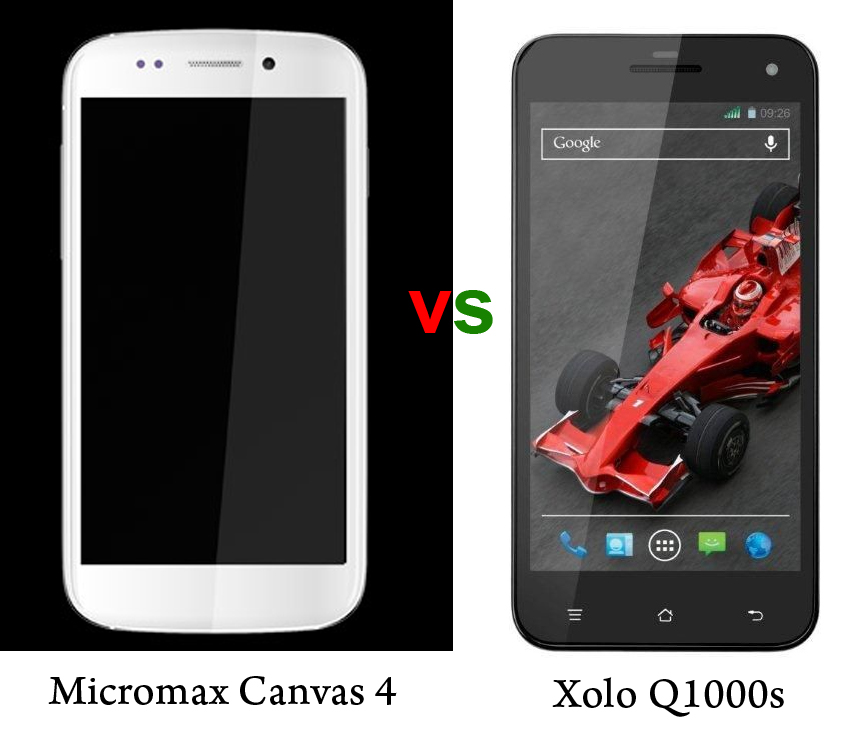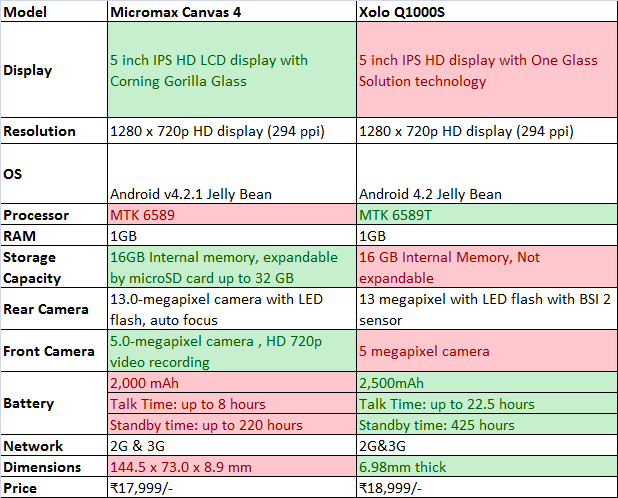Micromax had last month with great fanfare announced its newest entrant to its “Canvas” family when they launched the A210 Canvas 4. Before its launch, there was palpable expectation in the air thanks to the success its predecessors, the A110 and the A116 had achieved. While Micromax’s Canvas 4 launch was a high profile affair, there are a couple of handsets in the market from other Indian players who might not have as much marketing muscle as Micromax – but do have handsets that are no less spectacular than Micromax’s offerings. Some of these can match up and possibly even “beat” the Canvas 4 if they stand eyeball to eyeball.
That brings me to the Xolo Q1000s announced just a couple of days ago.

Now, Xolo is by no means a small brand any longer – and they have been doing quite a bit of advertising as well. But then, they’re obviously not as huge as Micromax. When I first heard about the specifications of the Xolo, my first instinct was to compare it to the Canvas 4. Let’s match up these two local behemoths in a face to face spec sheet war and see who comes out tops, shall we?!

Processor & Graphics
While both the phones seem to run the same MediaTek 6589 chipset that houses a Quad Core CPU as well as the PowerVR SGX544 GPU, on careful observation, you will notice that the one on the Xolo Q1000s is actually an enhanced version of the same – called the MT 6589T. Apart from having a higher clocked CPU (1.2 Ghz on the A210 VS 1.5 Ghz on the Q1000s), the MT 6589T also gets a faster GPU clock speed. This should give you (at least on paper) better gaming and UI performance. However, a lot matters also on the software optimizations on both these devices. As for Micromax, the thing that bothers me the most is that under the hood, the Canvas 4 is almost the same phone as the Canvas HD – using the same chipset as its older brother. They have added a few software gimmicks, more internal memory and a higher megapixel count on the camera module. Is the 4 to 5k that you pay extra for basically the same phone worth it? I would rather ask you to stick to the Canvas HD, had it not been for its rather paltry internal memory!
Winner: Xolo Q1000s
Camera
This is something that has to be actually tested before we can pronounce winner. Both the handsets here get awesome sounding 13 megapixel cameras and the ability to capture videos in full HD. Both also get an insane 5 megapixel front cameras. The spec sheet on the Q1000s doesn’t clearly state if the front camera can capture videos in 720p. So for now we will give this one away to Micromax – but who knows? The Xolo might actually have better image quality. Await a review to figure that out!
Winner: Micromax Canvas 4
Battery
The Xolo Q1000s with its 2500 mAH battery is the clear winner here. What is even more remarkable is the fact that the Xolo gets a bigger battery in spite of being significantly thinner than the Canvas 4 – 6.9mm as opposed to 8.9 mm. A 500 Mah difference is too great to be overlooked! That said, a final judgement will need a full review. Be patient till then.
Winner: Xolo Q1000s
Memory
Whatever gains the Xolo gets from its larger battery it loses out on not having an expandable memory option (there is 16 GB of internal memory, though). But then the Canvas HD apart from the inbuilt 16 GB also gets a memory card slot. It is always nice to have the option to increase memory further, isn’t it? The Canvas HD takes this one!
Winner: Micromax Canvas 4
Pricing
As of writing this, the Canvas 4 is retailing for around Rs.17,500 mark while the Q1000s received an official price tag of Rs. 18,999 which I expect to come down in the days to come. It is not an easy choice between these two. The Canvas HD offers you expandable memory and it comes at a slightly lesser price point. The Xolo Q1000s gets a slightly better processor, a larger battery and slimmer profile at almost the same price. In case you had made up your mind on the Canvas HD, the arrival of the Xolo Q1000s might only make it difficult for you.
Have we made things simpler for you?





